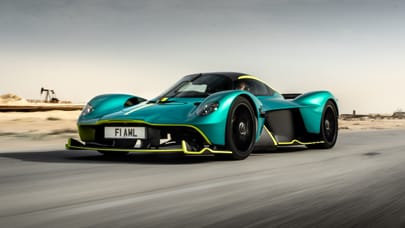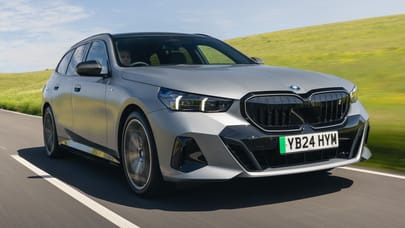
Mercedes-Benz AMG One review
Good stuff
Celebrating AMG’s struggle to get an F1 engine into a road car. Well-trimmed cabin and tenacious handling in lizard-like max attack mode
Bad stuff
The driving position is weird, the seat isn’t supportive enough and it's deafeningly loud inside
Overview
What is it?
The Mercedes-AMG One is first and foremost a hybrid hypercar. A 1,049bhp technical showcase for what Mercedes can achieve when it really puts its collective brain (and many euros) to a near impossible task: putting the engine from a 2016 Formula One world championship-winning racing car into a street-legal vehicle. And selling it to people without the skills of Sir Lewis. Gulp.
But the AMG One is also a story in itself. A car that was first presented in 2017, promising deliveries in 2019. Or 2020. Then there was a global pandemic, a critical parts shortage, and even by the time Mercedes’ dominant F1 form started to slip in 2022, the British-built One still wasn’t ready.
At long, long last, the One finally made it into production, with the first of the 275 customers receiving their £2.3m toys in autumn 2022 and the last by the end of 2023.
Photography: Mark Riccioni
How does it work?
A quick interlude now to explain or remind just how complicated this car is. At its heart sits a 1.6-litre single turbocharged V6. The turbo is effectively split along a shaft between the intake and exhaust and this allows a 120bhp electric motor to sit amid it, spooling up the boost long before exhaust pressure would have it ready. This is what F1 commentators call the MGU-H (Motor Generator Unit – Heat) and it effectively reduces turbo lag.
On the back of the internal combustion engine, which produces 566bhp (a staggering 353bhp per litre) is a bigger 161bhp electric motor (MGU-K, to F1 commentators, K for Kinetic) and they both drive the rear axle. Each of the front wheels has another 161bhp electric motor, which F1 commentators don’t have to worry about.
Peak combined power is a claimed 1,049bhp and no torque figure has been published because it is too difficult to calculate. Given that half the work is undertaken by electrons, we can probably summarise it as ‘plenty’.
The basic structure of the car is made from carbon-fibre, as is the bodywork. The engine is rigidly mounted to the tub. Almost no-one does this because the downsides are enormous: the engine vibrations are transmitted directly into the chassis, the carbon acts like a speaker amplifying them and you end up having to wear ear defenders. Alongside Aston’s Valkyrie the only other cars across the last 30 years that have followed suit are the Ferrari F50, Caparo T1 and BAC Mono.
The advantages are rigidity and lightweight. No need for the rear subframe to be so heavy when the suspension can be directly mounted to the drivetrain. The suspension itself is a complicated pushrod set-up, the transmission is closely related to the F1 cars and built by Xtrac and the car has substantial heaters to pre-warm the cats before start-up.
And that presumably makes it a trifle fast?
Mercedes’s claims of 0-62mph in 2.9sec, 0-124mph in 7.0sec and a 219mph maximum still seem pretty seismic, but they make it no faster than a McLaren 765LT. Having said that, the McLaren feels uncomfortably fast at times and we’re not sure how much faster a car needs to be, nor at which point we need to judge everything by how fast it is.
After all, most £1 million+ cars will get annihilated by a £35k motorcycle. But given the One weighs a bloated 1,695kg, it’s within the clutches of a lot of less expensive cars, not least Ferrari’s ballistic SF90 Stradale.
But don’t look at it in those terms – the experience is much more important than the numbers here.
So where have you driven it?
We have now driven it twice. The first time wasn’t a great success. Chris Harris drove it for the TV show back in 2022 at the Nürburgring Grand Prix track. The car was so faulty and glitchy that Merc had to wheel out a replacement, which had another slew of issues. All told Merc was so burned by the unreliability and criticism that ever since it has refused all our demands to have another go.
So our second experience came thanks to a very generous owner who gave us three days in September 2025 to use the car as we liked. So we spent two days on track at Thruxton, and a day on road. It didn’t miss a beat. Not one warning light, not one refusal to shift in and out of lizard mode. More than that, we discovered an intriguing, fascinating car.
Paint an overall picture of it.
You might think it looks slightly calm and demure with its beautifully trimmed and spacious cabin and fully covered bodywork. And seeing as this is the three-pointed star we’re talking about, you might doubt Merc’s commitment to making it extreme. You might be concerned, as we were before our second go, that Merc would just have got it running, done the basic development, but not delivered a fully rounded, cohesive car.
In fact it’s a fascinating, rewarding, genuinely uncompromised road car that fully deserves a place at the hypercar top table. It’s stiff, it’s noisy, it’s aggressive and it rewards hard driving, loves being taken by the scruff and hurled at a track.
What's the verdict?
The first time we drove it we were concerned. Concerned that not even the engineering might of Mercedes had fully managed to deliver on the dream of putting an F1 engine in a road car. Nevertheless, we were utterly intrigued by the AMG One and suspected that one of the most interesting and rewarding cars ever made might lurk under all that unresolved technology.
Our main fear was that, even on second sampling, we were going to find the AMG One unreliable and unfinished. That Mercedes had been so burned by the protracted development and constant criticism, that they had just shoved it out the door and collapsed, exhausted and disillusioned by the whole process. After all, in a moment of weakness, this is a car about which current CEO Ola Kallenius joked “we were drunk when we said yes” to signing it off.
Instead we found a car that didn’t miss a beat. That idled calmly at 1300rpm and screamed through to 11,000rpm. But you’d expect that from a Kia, let alone a £2.4 million hypercar, Happily, the AMG One goes a long way to justifying its expense in other areas. It’s a compelling car that’s as much a F1-level engineering achievement as it is an exciting road car. To genuinely appreciate it, you need to understand it, to realise the battles Mercedes has faced it getting it into production.
And they stuck to their guns – they didn’t do a Jaguar XJ220 and promise one thing, only to deliver quite another. They’ll never do it again, but that ensures this will be remembered not only as one of the great automotive follies, but also one of the most fascinating machines ever made.
The Rivals








